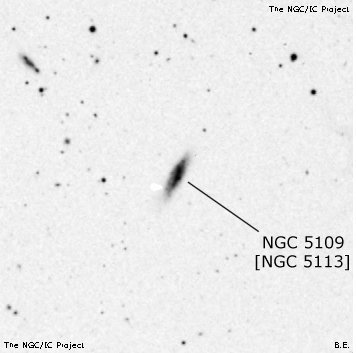NGC/IC Project Restoration Effort
(This is a very very beta version)
NGC5109


Basic Information
Location and Magnitude
Right Ascension: 13:20:52.6
Declination: +57:38:32
Constellation: UMA
Visual Magnitude: 12.9
Historic Information
Discoverer: Herschel W.
Year of discovery: 1790
Discovery aperture: 18.7
Observational
Summary description: cF, S, cE
Sub-type: Sbc
Corwin's Notes
=====
NGC 5109 = NGC 5113. Both objects were found by William Herschel, N5109 =
H II 826 on 17 March 1790, and N5113 = H III 808 eleven months earlier on 24
April 1789. His descriptions are very nearly the same: "F, S, E" and "cF,
S, E." John Herschel lists only one galaxy here (h1588) which he identifies
as H II 826 (= N5109), in spite of the fact that his father's position for
N5109 is a full minute of time and nearly two arcmin off, while that for N5113
is only 10 seconds of time and just over one arcmin off. Sir John's
description "vF, pmE, 30sec" is also closer to his father's "cF" for N5113
than it is to the "F" for N5109. Dreyer followed Sir John's lead here, but
added a note to the NGC description: "perhaps = N5109." He reinforced this
in his 1912 MN paper and collection of Sir William's papers, and suggested
that the number N5113 be discarded. Reinmuth agreed, and accepted the
equality of the two numbers.
CGCG, however, located a small galaxy six arcmin north of the NGC position
for N5113, and assigned the number to that galaxy. UGC followed along. Given
the data above, and the fact that this galaxy is 1.6 magnitudes fainter than
the brighter one, this identification is certainly incorrect. So, I have
followed Dreyer (1912) in equating the two NGC numbers.
The galaxy itself is a peculiar spiral, with a knotty bar-like structure in
the middle. The SDSS image shows that the bulge and nucleus are offset into
the northern end of the object, while this knotty structure toward the middle
is actually a group of bright HII regions. So, I have taken the nucleus to be
located eccentrically in the northern end. Note that many of the published
positions, as well as those that I measured earlier, apply to the more
centrally-located knots; I've labeled them as such in the table.
Steve's Notes
=====
NGC 5109
18" (5/30/03): fairly faint, nearly edge-on 7:2 NNW-SSE, 1.2'x0.35', broad concentration with a slightly brighter core.



